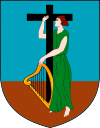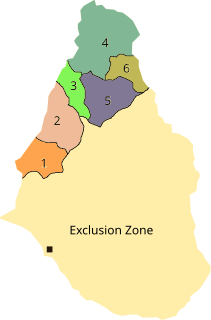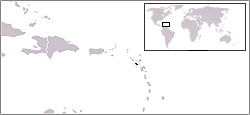 |
|---|
General elections were held in Montserrat in 1940. [1]
 |
|---|
General elections were held in Montserrat in 1940. [1]
The Legislative Council had nine seats; four elected, three held by government officials and two by nominees appointed by the Governor. [2]

Montserrat is a British Overseas Territory in the Caribbean. It is part of the Leeward Islands, the northern portion of the Lesser Antilles chain of the West Indies. Montserrat is about 16 km (10 mi) long and 11 km (7 mi) wide, with roughly 40 km (25 mi) of coastline. It is nicknamed "The Emerald Isle of the Caribbean" both for its resemblance to coastal Ireland and for the Irish ancestry of many of its inhabitants. Montserrat is the only non-fully sovereign full member of the Caribbean Community and the Organisation of Eastern Caribbean States.
Politics of Montserrat takes place in a framework of a parliamentary representative democratic dependency, whereby the Premier is the head of government, and of a multi-party system. Montserrat is an internally self-governing overseas territory of the United Kingdom. The United Nations Committee on Decolonization includes Montserrat on the United Nations list of non-self-governing territories. Executive power is exercised by the government. Legislative power is vested in both the government and the Legislative Assembly. The Judiciary is independent of the executive and the legislature. Military defence is the responsibility of the United Kingdom.
The Leeward Islands are a group of islands situated where the northeastern Caribbean Sea meets the western Atlantic Ocean. Starting with the Virgin Islands east of Puerto Rico, they extend southeast to Guadeloupe and its dependencies. In English, the term Leeward Islands refers to the northern islands of the Lesser Antilles chain. The more southerly part of this chain, starting with Dominica, is called the Windward Islands. Dominica was originally considered a part of the Leeward Islands, but was transferred from the British Leeward Islands to the British Windward Islands in 1940.

The flag of Montserrat consists of a Blue Ensign defaced with the British overseas territory's coat of arms. Adopted in 1960 to supplement the Union Jack after the dissolution of the British Leeward Islands the year before, it has been the flag of Montserrat since the territory was granted self-government that year. The design of the present flag entailed enlarging the coat of arms and outlining it with a white trim. Montserrat's flag is similar to the flags of eight other British Overseas Territories, which are also Blue Ensigns with their respective coats of arms.

The Soufrière Hills are an active, complex stratovolcano with many lava domes forming its summit on the Caribbean island of Montserrat. After a long period of dormancy, the Soufrière Hills volcano became active in 1995 and has continued to erupt ever since. Its eruptions have rendered more than half of Montserrat uninhabitable, destroying the capital city, Plymouth, and causing widespread evacuations: about two-thirds of the population have left the island. Chances Peak in the Soufrière Hills was the highest summit on Montserrat until the mid-1990s, but it has since been eclipsed by various rising and falling volcanic domes during the recent volcanic activity.

Elections in Montserrat take place within the framework of a multi-party democracy and a parliamentary system. The Legislative Assembly is directly elected, and a Chief Minister is selected by the party or coalition with the most seats in the Assembly.

The coat of arms of Montserrat consists of an escutcheon (shield) charged with a woman in a green dress holding a golden harp and a black cross. In use since at least 1909, it has been the official coat of arms of the Caribbean island of Montserrat since the island became a British Crown colony in 1962. The escutcheon is featured on the flag of the territory.
The Montserrat Democratic Party (MDP) was a political party in Montserrat.

Santa Maria de Montserrat is an abbey of the Order of Saint Benedict located on the mountain of Montserrat in Monistrol de Montserrat, Catalonia, Spain. It is notable for enshrining the image of the Virgin of Montserrat. The monastery was founded in the 11th century and rebuilt between the 19th and 20th centuries, and still functions to this day, with over 70 monks. There have always been roughly 80 monks in residence.

The following is an alphabetical list of topics related to the British Overseas Territory of Montserrat.

Lesbian, gay, bisexual, and transgender (LGBT) persons in Montserrat face legal challenges not experienced by non-LGBT residents. Same-sex sexual activity has been legal in Montserrat since 2001.

Spanish irredentism mainly focuses on claims over the British overseas territory of Gibraltar, whose long-standing territorial vindication as a British colony is enshrined in the Spanish foreign policy. Along history, other minor irredentist proposals have claimed territories such as the whole of Portugal, Andorra, parts of Northern Africa, the Roussillon and the French Basque Country.
General elections were held in Montserrat on 20 February 1952. They were the first elections in Montserrat held under universal suffrage, which had been introduced the previous year. The result was a victory for the Montserrat Labour Party, which won all five seats in the Legislative Council.
General elections were held in Montserrat on 18 March 1955. The result was a victory for the Montserrat Labour Party, which won three of the five seats in the Legislative Council. The other two seats were taken by the independent candidate Robert William Griffith and a Merchant Planter, William Lleweyn Wall.
General elections were held in Montserrat on 8 May 1958. The result was a victory for the Montserrat Labour Party, which won four of the five seats in the Legislative Council.
General elections were held in Montserrat in 1966. The result was a victory for the Montserrat Labour Party, which won five of the seven seats in the Legislative Council. MLP leader William Henry Bramble remained Chief Minister.
The Montserrat Labour Party (MLP) was a political party in Montserrat.
General elections were held in Montserrat in 1937. They were the first elections since the 1860s.
General elections were held in Montserrat in 1943.
General elections were held in Montserrat in 1946.